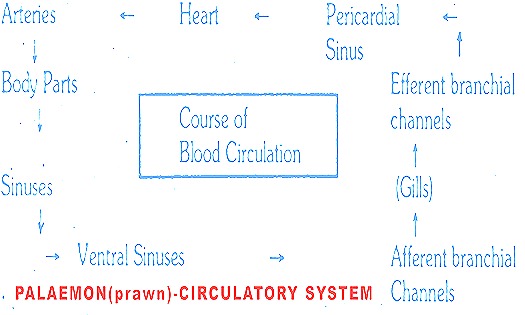PALAEMON- (PRAWN) BLOOD VASCULAR SYSTEM
PALAEMON-CIRCULATORY SYSTEM
In Palaemon the circulatory system includes blood, dorsal sinus, heart, blood vessels, blood sinuses, blood channels. The circulatory system is open type. The arteries open into blood sinuses in the body.
Blood:
1. It is colorless watery fluid.
2. It contains amoeboid cells.
3. The respiratory pigments is haemocyanin, hence the blood is bright blue in color when combined with oxygen. It is colorless when de-oxygenated.
4. Blood distributes digested food, oxygen to all body parts.
5. Blood has the capacity of clotting.
Dorsal sinus: The heart is dorsally placed in the posterior part of thorax. It is enclosed in a chamber called the dorsal sinus or pericardium. It is present above the hepato pancreas and the gonad. It shows a thin septum on the floor. The septum is attached to the dorsal body wall and to the thoracic wall.
Heart: It is a muscular organ. Its apex is directed anteriorly. Broad base is directed posteriorly.
Cardio-pyloric strand and two lateral strands will keep the heart in position inside the pericardium. On the wall of heart five pairs of valvular Ostia are present. Blood from dorsal sinus can enter into the heart through Ostia.
i) First pair of Ostia - Mid dorsal.
ii) Second pair of Ostia - Mid ventral.
iii) The third pair - Posterior.
iv) The fourth pair - Antero laterally,
v) The fifth pair-Postero laterally.
Blood vessels or arteries:
The heart sends blood to the body through the arteries. They are.
a) Median ophthalmic arteries: It arises from the apex of the heart. It runs forward mid-dorsally to head. It joins the two antennary arteries above the oesophagus in cephalic region.
b) Antennary arteries: A pair of antennary arteries arises from the apex of the heart on both sides of the median ophthalmic artery. Each artery runs forwards along the outer border of the mandibular muscle. Its branches are
1) Pericardial branch goes to pericardium.
2) Gastric branch goes to cardiac stomach in prawn digestive system.
3) A mandibular branch goes to mandibular muscle. Then it divides into a dorsal branch and a ventral branch. The ventral branch gives branches to antennule, the antenna and the renal organ. The dorsal branch gives branches to the eye and then divide. It unites with the same opposite branch and the median ophthalmic to form a circular loop like artery or circulus cephalicus. It gives a pair of rostral arteries to the-rostrum.
Hepatic arteries : They arise' from heart ventro-laterally one on each below the antennary artery. They go to the hepatopancreas.
Median posterior artery : A short stout artery arises from the postero -ventral surface of the heart. It bifurcates into a supra-intestinal artery and a sternal artery. The supra intestinal is also called dorsal abdominal artery which supplies blood to the midgut and the dorsal abdominal muscles. The sternal artery runs downwards through the hepatopancreas and then pierces the ventral thoracic ganglionic mass and go to the ventral side. It divides into ventral thoracic branch and ventral abdominal branch. The ventral thoracic branch supplies blood to the sternal region, the first three pairs of walking legs, the maxillae and the maxillulae. The ventral abdominal branch runs posteriorly up to the anus and supplies blood to ventral abdomen, the last two pairs of legs, the hindgut etc.
Blood sinuses : True capillaries and veins are absent. In Palaemon arterial branches end in blood sinuses of the haemocoel. All the sinuses of the body open into a pair of ventral sinuses. It is present below the hepatopancreas.
Blood channels: These have no proper walls. Six afferent bronchial channels carry blood from ventral sinus to the gills on both the sides. Oxygenated blood from the gills of both sides is brought to the pericardium by six afferent bronchial channels.
Circulation of blood: The heart because of contractions forces the blood through the arteries to all parts of the body. Blood from all sinuses will return to two ventral sinuses. From there the blood is distributed to the gills by afferent bronchial channels and then it reaches the pericardial sinus through efferent bronchial channels and reach heart.

